Website design planning will set you up for success in every project stage, whether you do it yourself or hire help. Learn how to plan a website that attracts and converts visitors.
Imagine if your website delivered as many leads, sales, and opportunities as you wanted.
Imagine if your website looked impressive, and you were proud to use it to represent your business.
What if it connected with all your business systems and automatically processed data, so you didn’t have to do it manually?
A well-planned website can do all these things.
That’s why the top-performing, highest-converting, most beautiful websites didn’t get built haphazardly—they were designed with a plan.
Free Website Design Planning Template
Download the Structure Website Design Planner and use it to define and design your website!
Maybe you just finished a brand overhaul.
Or you’re launching a new product or service. Perhaps you’re even preparing for a new level of growth.
Whatever your reason, a website design or redesign project can be a huge success or a colossal failure.
A strong plan creates a smooth process.
Fear not! After designing our first website in 2010, I can confidently say that a strong web design plan creates a smooth web design process.
That’s worth repeating. A strong website design plan creates a smooth website design process.
In this article, we will pull back the curtain and share the Structure website design planning process, end-to-end.
This is the same process we use to create $50,000+ websites that look amazing and generate more business than you believe. Let’s start!
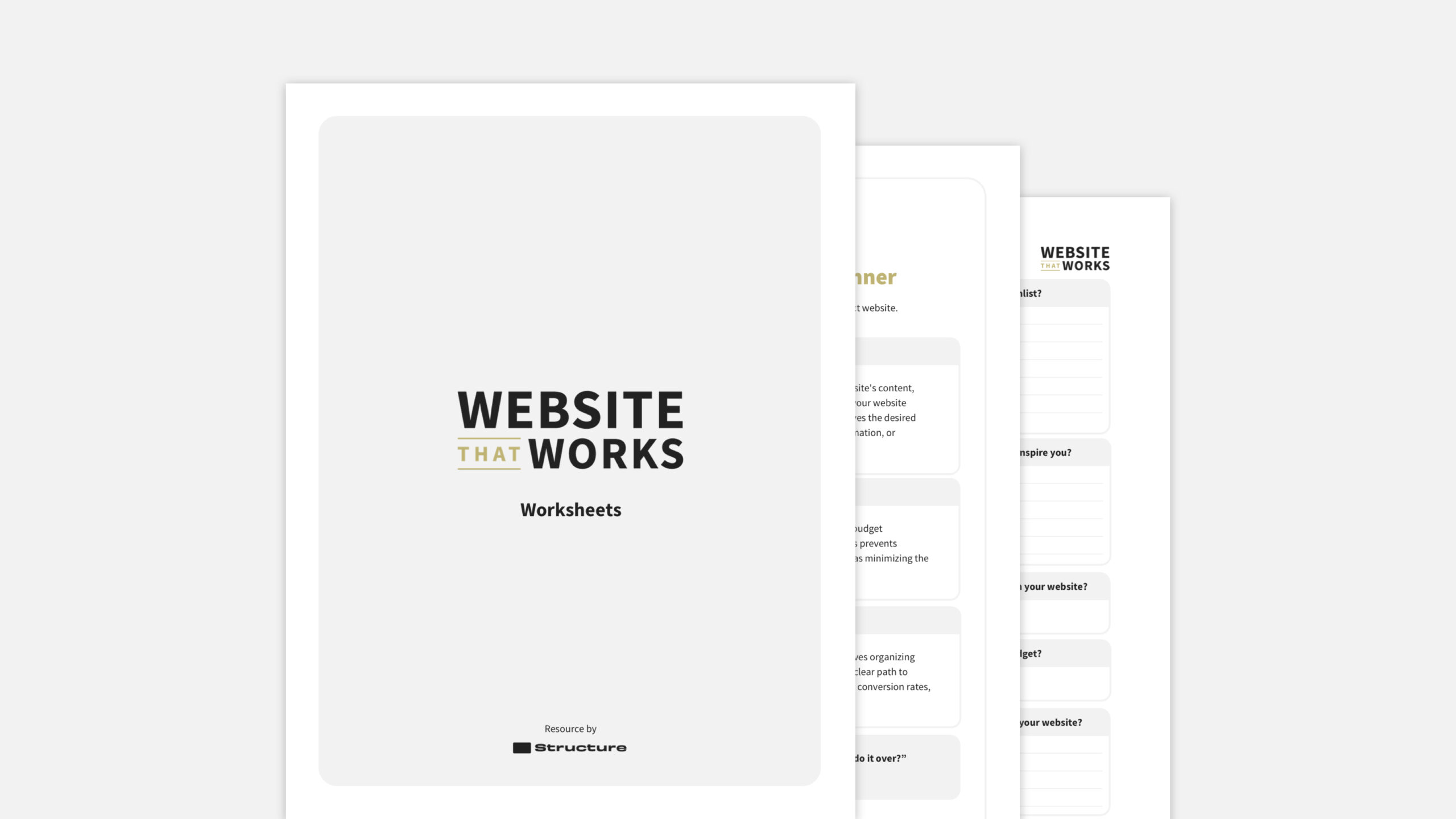
Website Design Planning Sucks
Most websites we’ve redesigned never started with a plan, so we were hired to redesign them!
Of course, our website redesign process includes planning, but most people don’t start there.
Instead, they start at a random point in the process and hope they don’t skip over anything with too many downstream effects.
I’m giving most folks a hard rap, but the truth is, I understand entirely. Website design planning sucks (most of the time) for a few reasons.

1. Planning a website design takes time
Let’s be honest.
Most business leaders, marketing leaders, and entrepreneurs are busy. They want to accomplish work quickly.
Planning in general (and website planning in specific) is the last thing we want to slow down to do.
We all love a good plan’s clarity, calmness, and conclusion. However, it is tricky to block out the time on your calendar and prioritize the thinking time to do it.
The website builder platforms (like Wix, Squarespace, Duda, GoDaddy, Weebly, etc.) know this.
That’s why, when you sign up to build a DIY website, you start by picking a template and jump right into the building. They skip the planning, assuming you already did or will never do it.
The good news is that website planning doesn’t have to take as much time as you’d think.
By following the planning process we share in this article and utilizing our free Website Design Planning Guide, you’ll save lots of time because you’ll know what to do.
2. Website planning takes knowledge
It’s true.
Website planning takes a basic understanding and knowledge of a website, how it works, and its role in your business.
Therefore, when you go to “plan” a website, you may not know where to start or what to do. That’s okay; it’s another reason why having a Website Design Planning Guide can help.
If this is you, consider watching our (free) training on your website’s role in your business and how it affects each part of your marketing. It will help you better understand your website before you start the planning process. You can check it out HERE.
3. Web design planning is uninteresting
When most people think about a website design (or redesign), they think first about the art aspect of the website.
They think about the website’s appearance: the logo, colors, fonts, and images.
We like to look at beautiful things.
However, most people don’t realize a website is 25% art and 75% science.
In some ways, a website is like an iceberg. The art is the tip—the piece that stands out that everyone can see.
However, most of what goes into a website happens behind the scenes.
We tell our clients this: great websites are much more FORMULAIC than most people think. Our website design planning process is a formula that will give you results if you follow it.
4. The work to define a website requires alignment
Now, it’s time to face the music.
One of the biggest reasons website planning sucks is that your team has to define, align, and make decisions.
That can be a challenge for any team, whether you’re website design planning or strategic planning.
However, alignment is one of the biggest reasons organizations don’t define their website—and if they do, it’s an insanely painful process.
Our Website Design Planning Guide helps organizations find alignment easier because the planning process isn’t ambiguous or random.
You can work through the website planning process in just a few short meetings.
Free Website Design Planning Template
Download the Structure Website Design Planning Guide and use it to define and design your website!
How You Can Do Website Design Planning Right
The Structure Website Design Planning Process starts with the Define Phase, which takes four work sessions in our Website Planning Workshop, utilizing different worksheets in each work session.
- Session 1: Strategy
- Session 2: Shape
- Session 3: Systems
- Session 4: Schedule
Let’s start by digging into the first item.
1. Strategy Worksession
This work session serves as the kickoff point for the planning process.
In this session, you won’t think about your website or user needs as much as your business needs.
This session includes the following worksheets:
Vision Worksheet
The vision worksheet helps you document what you’re hoping to create.
It won’t help you create a lofty, unrealistic vision for something you can’t afford. It’s intended to stay practical and specific.
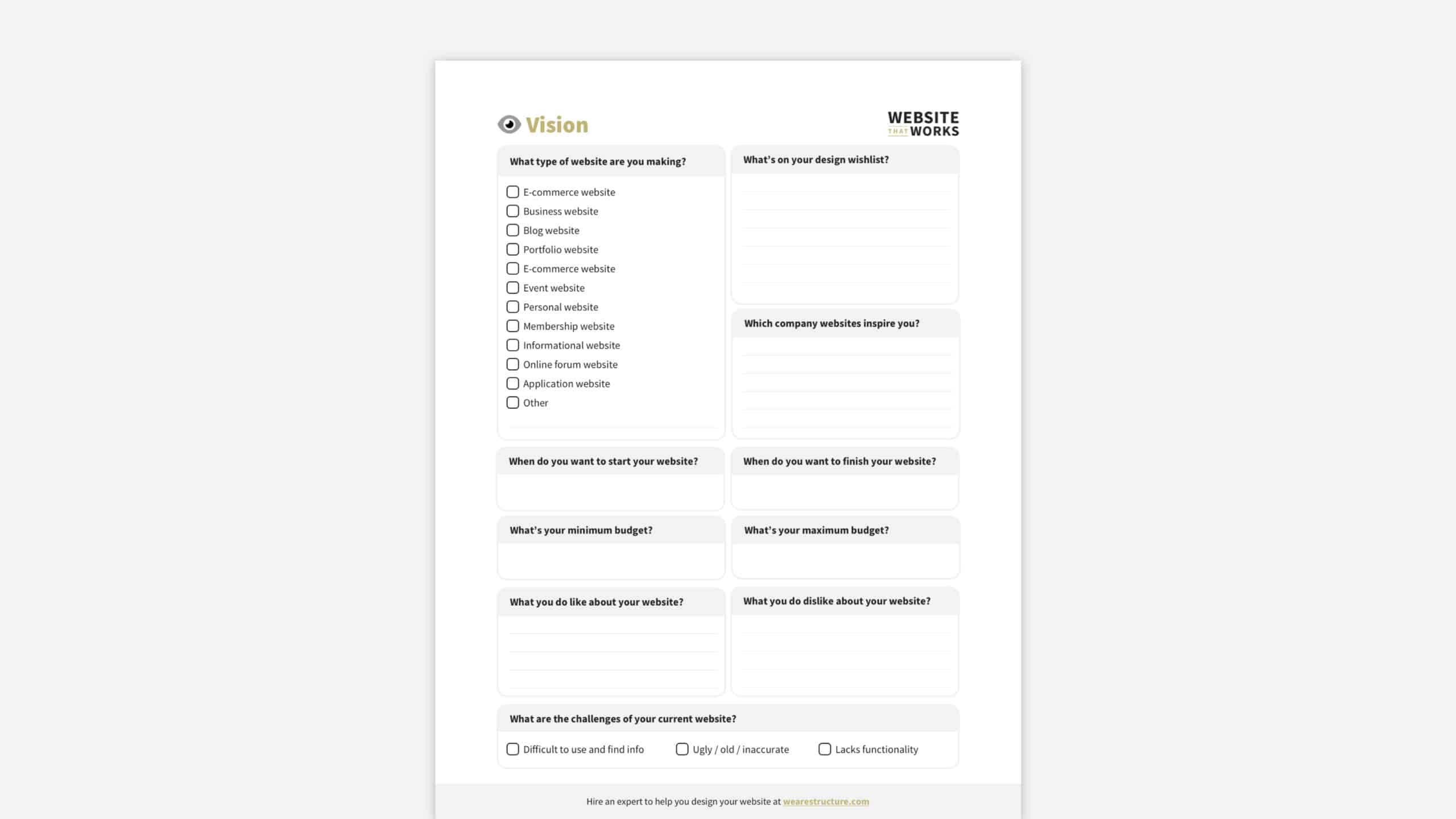
Goals Worksheet
The goals worksheet aims to align your team around your website project’s purpose.
It also clarifies your website’s goals and how to know if it delivers the desired results.
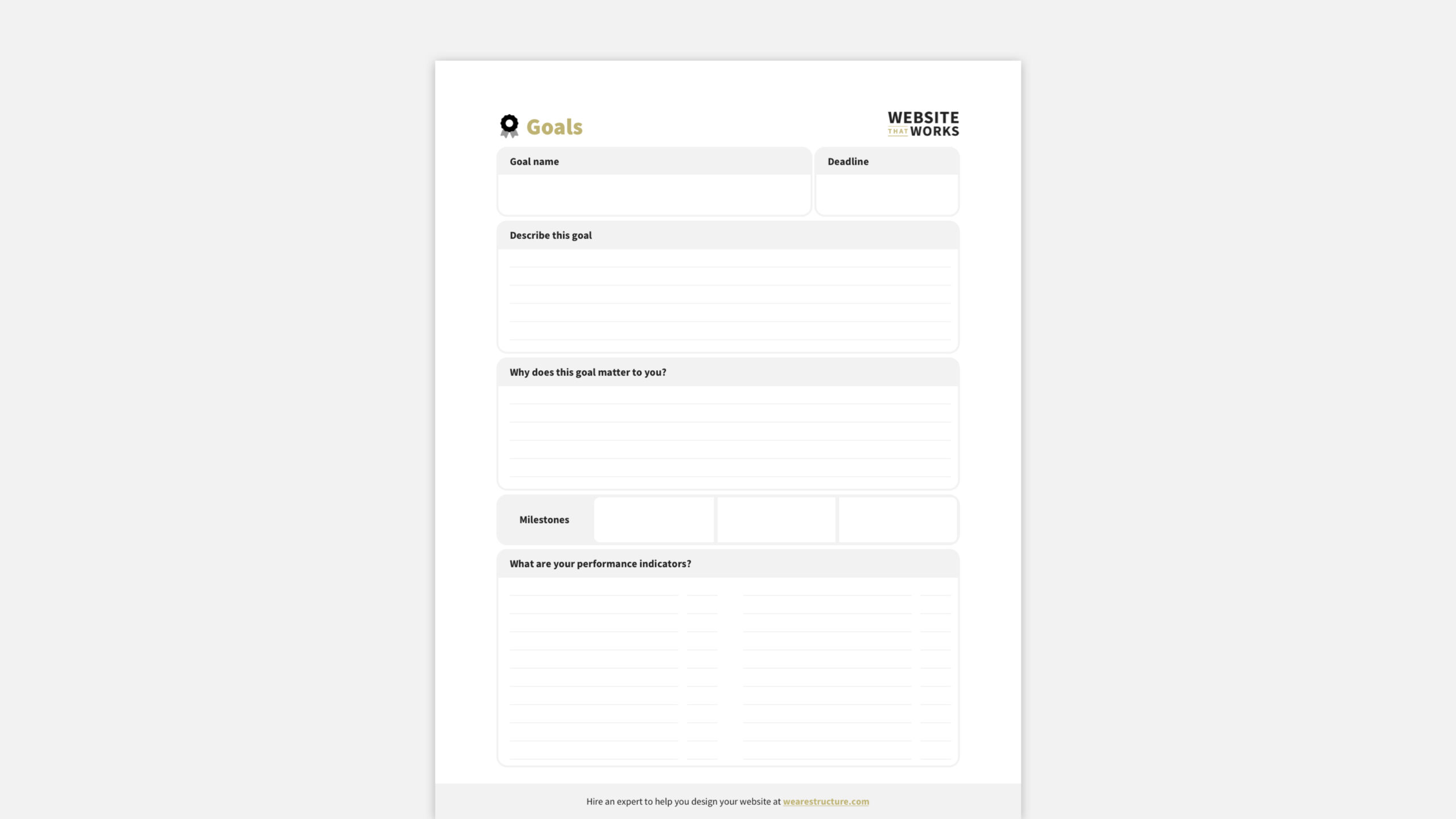
Team Worksheet
The team worksheet uses the DARCI Framework to define roles and responsibilities for your team.
This helps you know your strengths and weaknesses and ensures you aren’t stepping on each other’s toes.
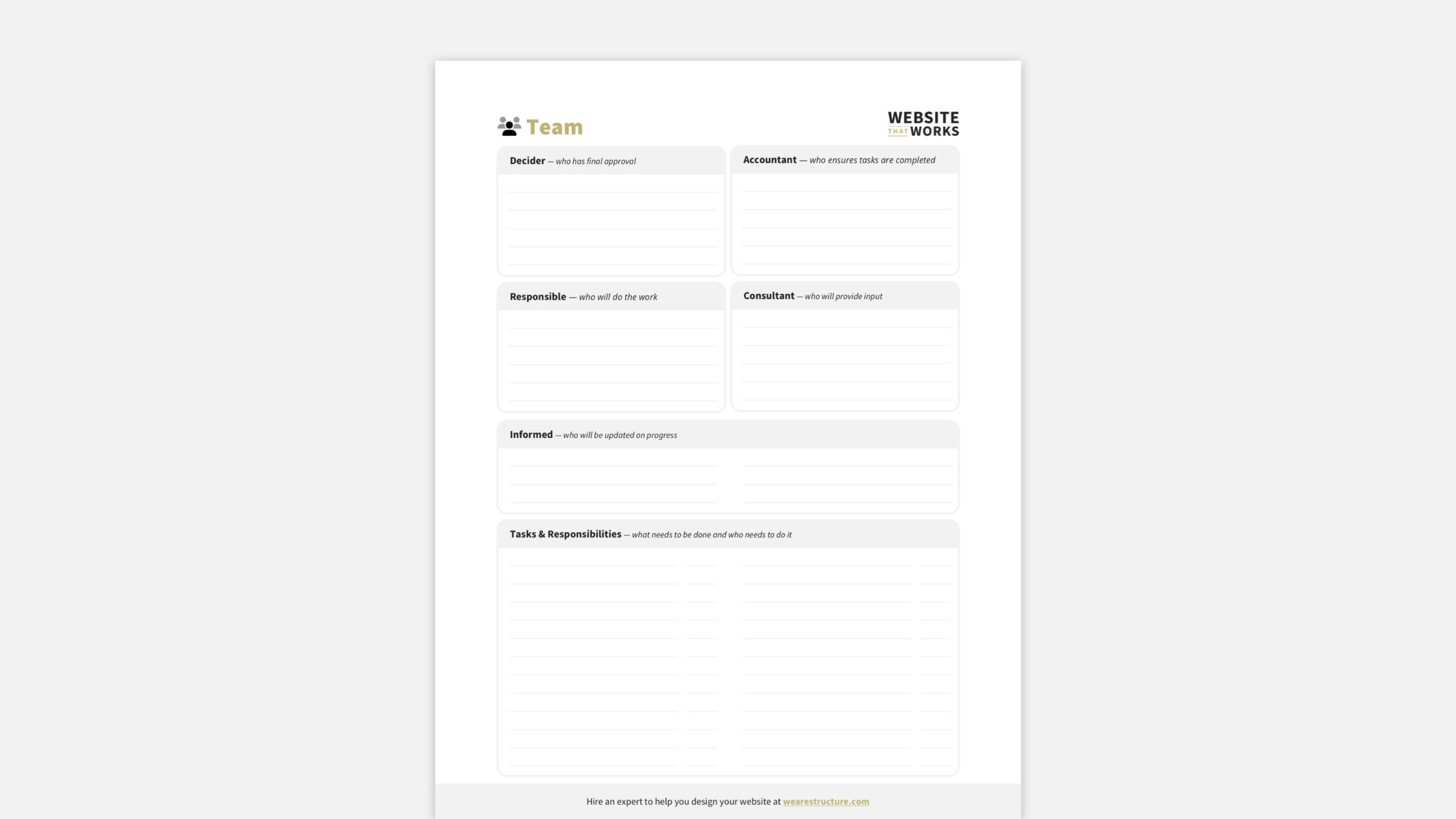
2. Shape Worksession
This work session is the second of three.
It builds on your website strategy to define the systems that will make your website work for your business—and create an exceptional experience for your customers, too!
Customer Journey Worksheet
The customer journey worksheet helps you document how your customers buy from you. It lets you know your customers’ touchpoints with your website—which is a pivotal factor in knowing which pages are vital to the website.
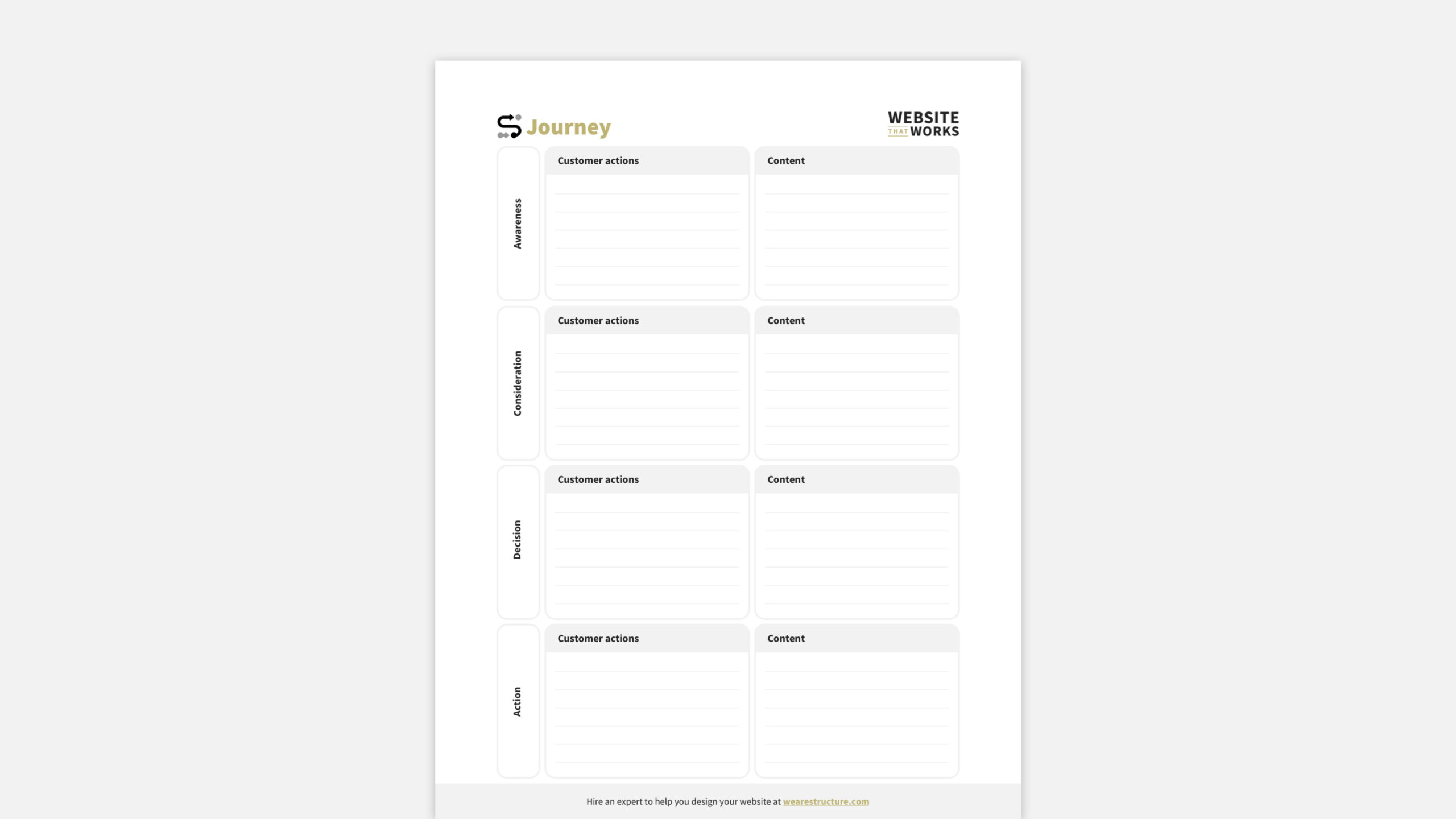
But most importantly, the Customer Journey worksheet lays the foundation for your website’s information architecture.
If you’re not familiar with this term, it essentially means:
- What information is included on your website
- How that information is laid out
- Where it has the most impact
Diving into information architecture is worth another blog post in itself and is something that you’ll lean on a UI (user interface) and a UX (user experience) website designer to help you with.
They’ll structure the information and lay out the visual elements to guide your customers through the perfect journey.
More on this after the website planning process is complete.
Sitemap Worksheet
The sitemap worksheet helps you assess your website’s current pages and, in conjunction with the Customer Journey Worksheet, enables you to define the pages needed on your new website.
You can also determine which pages to link in your header and footer navigation.
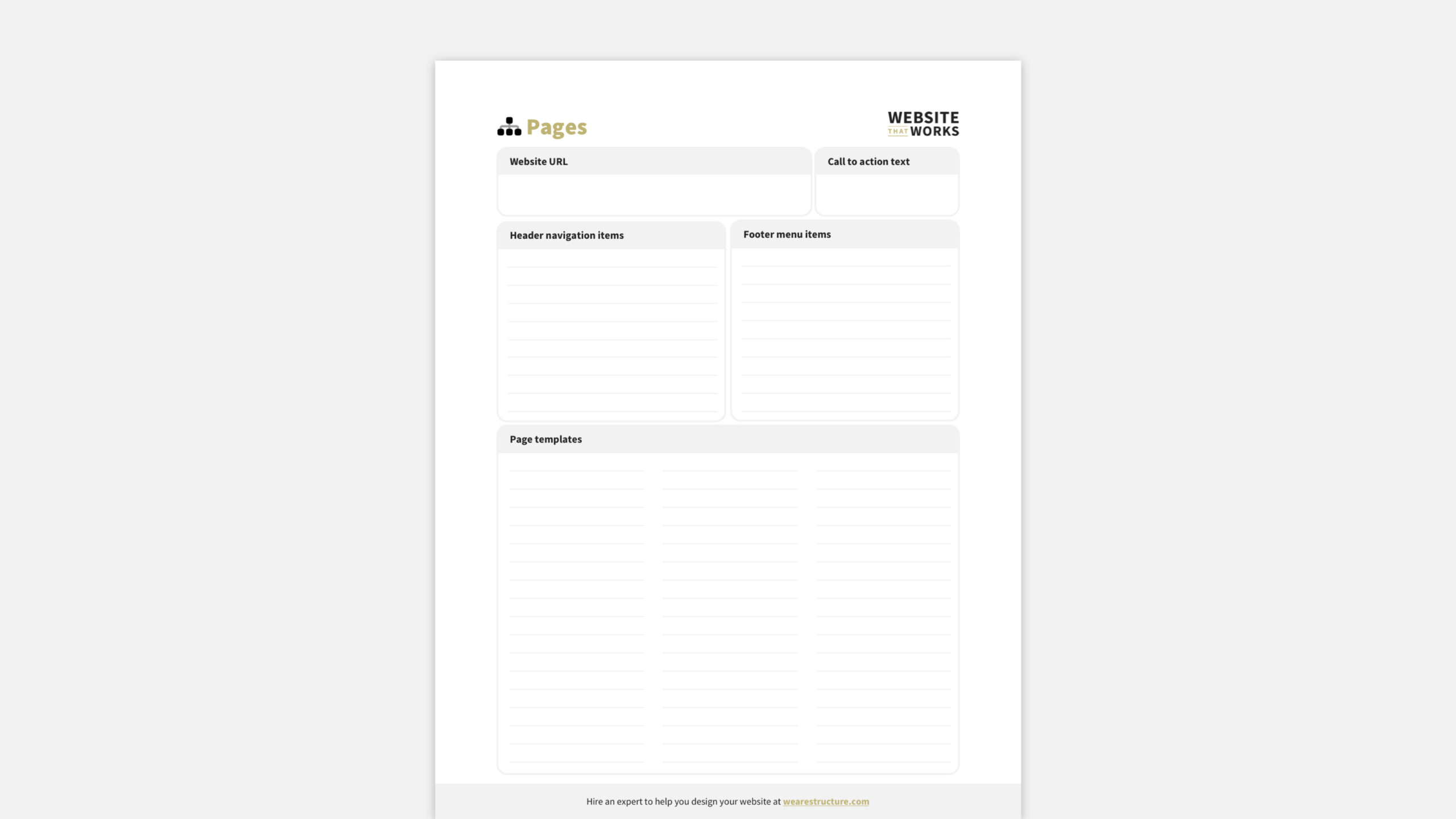
3. Systems Worksession
The third website design planning work session looks at how your website interacts with all functions in your business.
You see, many think that the website is only a marketing and sales function. But that’s not true!
It can be a tremendous resource for other functions like Administration, Finance and Human Resources, Operations, and more.
Spend this time planning how your website systematically can save time and money through digital automation.
Business Systems Worksheet
The last worksheet in this session is the business systems worksheet.
This helps your team become aware of the business systems you’re currently integrating with your website. Additionally, it helps facilitate any changes or upgrades needed before you get too far down the road.
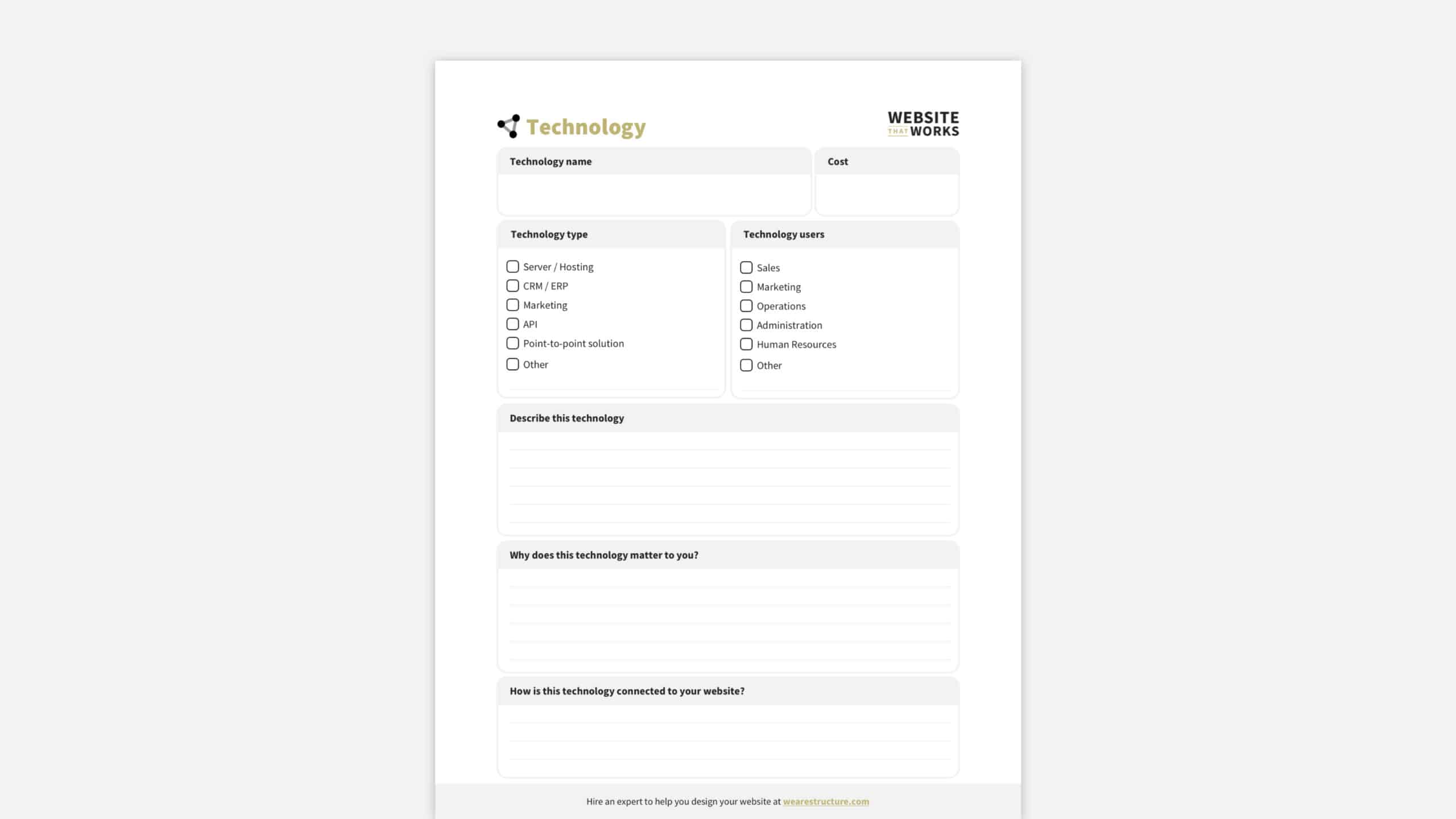
4. Schedule Worksession
This final session includes one worksheet intended to set the stage for the design process by bridging the gap between your plans and visual design. Everything you’ve done so far in the planning process will be summarized in your wireframe worksheet.
Budget Worksheet
The budget worksheet is intended to help you estimate the value of your website.
Most website budget worksheets only focus on the cost—ours take a more value-based approach and looks at the Return on Investment (ROI).
We help you list how your website will generate revenue and what expenses should be considered. The goal is to answer this question: Revenue – Costs = ROI.
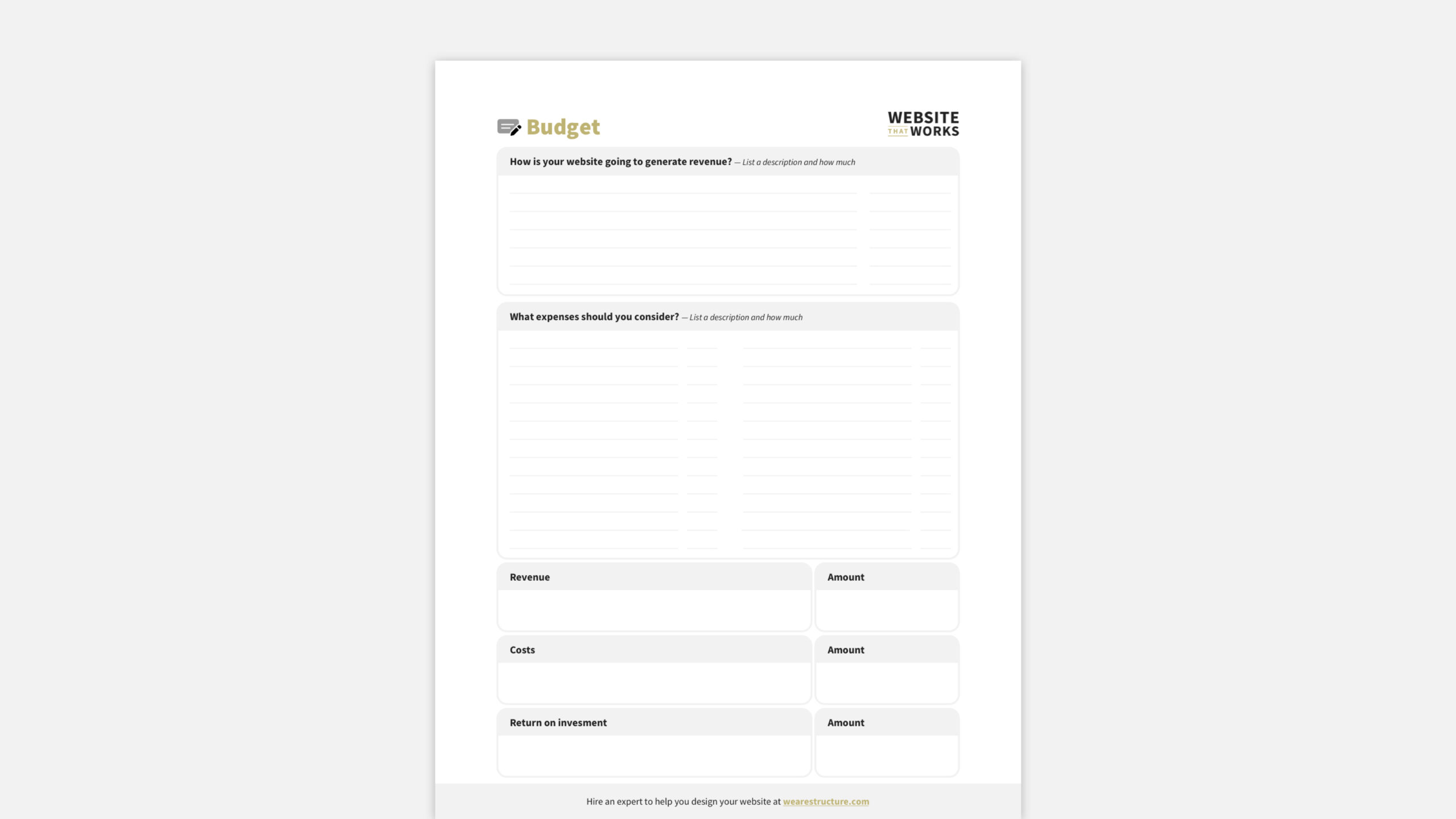
How Structure Can Help with Website Design Planning
So, that’s how we do website design planning at Structure.
It’s a process, no doubt!
However, I hope you can see that you’ll walk away with a comprehensive website plan by breaking down the planning process into three focused sessions with a few worksheets.
You can guarantee your upcoming website is already stepping ahead of your competition.
1. Download the Free Website Design Planner
If you’d like to use our process for your website planning, go ahead! Get each worksheet for free when you download the Website Design Planning Guide.
2. Register for a Structure Website Strategy Workshop
Spend a few days with Structure to plan your website, and we’ll save you a few months of mistakes trying to figure it out independently.
3. Watch Our Free Website Training
We’ve put together an excellent training on your website’s role in your business and how it affects each part of your marketing.
It’s called How to Build a Really Attractive, High-Converting Website That Makes You Proud.
It will help you better understand your website and set you up perfectly for the planning process.
4. Learn How Our Process Works
Now that you know the Structure website design planning process, you might wonder how the other steps work.
- When do we start the design?
- Where does development fit into the process?
- What steps do you need to take in which order?
Check out our website’s How It Works page for the step-by-step breakdown.
5. Take Our WebsiteBuilder Quiz
If you’re considering hiring a Structure to help with your website design or redesign and want to know what it would cost, take our quick Website Design Quiz.
It lets you tell us about your business, website goals, and timeline and will recommend a design package to get you started.
6. Schedule a Free, 30-minute Consult Call
We’re excited to help!
You can take the call yourself or bring your team (the more, the merrier). Schedule a call if you’re ready to talk to one of our experts about your website.
We’ll discuss your website, you’ll get free advice and guidance, and we’ll recommend a personalized package that fits your unique needs.

Website Design Planning FAQs
What is website design planning?
The first step of a website redesign is web design planning.
Planning entails determining and documenting the type of and how exactly your firm wants to create a website and why or what the goals are.
Website design planning is also known as Website Strategy.
This step is crucial because it allows everyone on the project to be on the same page about what needs to be accomplished with the new or redesigned website.
A well-crafted website strategy will answer five key questions:
- Who are we designing this website for? (Hint: It’s not just “anyone who visits the site.”)
- What do we want them to do when they get there?
- What content will be most useful/relevant/engaging for this audience?
- What are our business goals for this website?
- Who is responsible for content creation and maintaining the website content?
You must return to the drawing board if you can’t answer these five questions. Trying to build a website without a clear strategy is like playing darts in the dark—you might eventually hit the target, but it will take much longer (and be much less fun) than if you turned on the lights first.
Does every website need website design planning?
The answer is yes… if you want your website to accomplish clear goals—such as generating leads, taking orders, or communicating with your target audience.
We strongly recommend doing some strategy work for most websites before diving into design and development. Trust us; it will save you time (and money) in the long run.
However, there’s always an exception; not every website needs formal design planning.
For example, a website for a personal blog or small business that’s just getting started, for example, may not need the same level of strategic thinking as a large enterprise website or an ecommerce site.
In these cases, “Yes, informally may be a sufficient answer. You should consider the five website strategy questions in the above answer from a high level.
Who is website design planning for?
While the planning process is crucial for everyone involved in creating or redesigning a website, it’s essential for two groups of people:
- The project stakeholders, who are responsible for approving the budget and timeline for the project plan
- The project team who will be doing the actual work of designing and building the website
Project stakeholders are often high-level decision-makers, such as the CEO, CFO, or CIO.
Often, for our clients, it’s the CEO, VP of Marketing, and Marketing Director. Some may not be intimately familiar with all the project details, but they must understand enough to make informed decisions about allocating resources.
On the other hand, the project team will be deeply involved in every step of the process, from researching the competition to writing content to designing and coding the website.
They must understand the project goals to do their jobs effectively and clearly.
Both groups need to be involved in the website design planning process.
Stakeholders need to provide input on the website’s overall purpose and goals, while the project team can offer insights on how best to achieve those goals.
What are the benefits of website design planning?
There are many benefits to taking the time to do formal website design planning, including:
- A more precise understanding of the project goals
- Improved communication between stakeholders and the project team
- A more efficient and effective design and development process
- A website that’s more likely to meet the needs of its users
- Improved ROI for the business
When done correctly, website design planning can help everyone understand what needs to do and why. This, in turn, leads to better communication, a smoother design and development process, and a final product that’s more likely to achieve its goals.
What are the steps I need to take to plan a website?
No one-size-fits-all answer to this question exists; every team will do it differently. Our team, however, uses the three-step process outlined in this article’s body.
- Strategy Worksession
- System Worksession
- Shape Worksession
We’ve found that this approach leads to the best results, but you may need to adjust it to fit the specific needs of your project.
The planning process doesn’t have to be complicated or time-consuming.
By taking a structured approach and involving all the key stakeholders, you can ensure everyone is on the same page. You will save time and money in the long run, and it will help you build a better website structure.
Where can I find a website design planning template?
Right here!
Download the Structure Website Design Planning Guide for your website project’s A to Z roadmap.
Furthermore, this is the same website planning template we use to create $50,000+ websites that look amazing and generate more business than you believe.
How important is website design planning?
Website design planning is the most critical part of a website design.
Period.
Unquestionably, there’s nothing more vital that you can do for your future website than starting with a plan.

